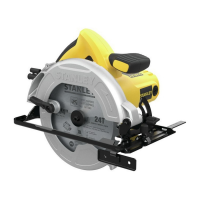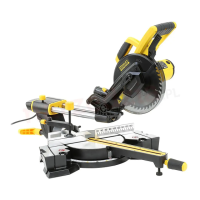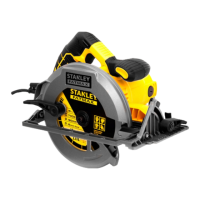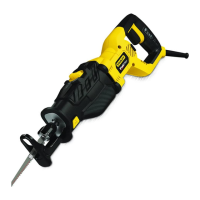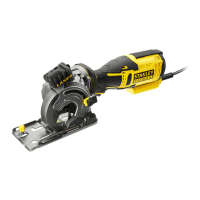ENGLISH
22
The two sketches (Fig. 29, 30) are for four side objects
only. As the number of sides changes, so do the mitre and
bevel angles. The chart below gives the proper angles for
a variety of shapes, assuming that all sides are of equal
length. For a shape that is not shown in the chart, divide
180° by the number of sides to determine the mitre or
bevel angle.
No. of sides Angle mitre or bevel
4 45°
5 36°
6 30°
7 25.7°
8 22.5°
9 20°
10 18°
Compound Mitre (Fig. 29–32)
A compound mitre is a cut made using a mitre an-
gle (Fig. 30) and a bevel angle (Fig. 29) at the same
time. This is the type of cut used to make frames
or boxes with slanting sides like the one shown in
figure 31.
WARNING: If the cutting angle varies from cut to
cut, check that the bevel clamp knob and the
mitre lock knob are securely tightened. These
knobs must be tightened after making any
changes in bevel or mitre.
♦ The chart shown below will assist you in selecting the
proper bevel and mitre settings for common compound
mitre cuts. To use the chart, select the desired angle
“A” (Fig. 32) of your project and locate that angle on the
appropriate arc in the chart. From that point follow the
chart straight down to find the correct bevel angle and
straight across to find the correct mitre angle.
♦ Set your saw to the prescribed angles and make a few
trial cuts.
♦ Practice fitting the cut pieces together.
♦ Example: To make a 4 sided box with 25° exterior
angles (angle “A”) (Fig. 32), use the upper right arc.
Find 25° on the arc scale. Follow the horizontal
intersecting line to either side to get the mitre angle
setting on the saw (23°). Likewise follow the vertical
intersecting line to the top or bottom to get the bevel
angle setting on the saw (40°). Always try cuts on a few
scrap pieces of wood to verify the settings on the saw.
Cutting Base Mouldings
The cutting of base moulding is performed at a 45° bevel
angle.
♦ Always make a dry run without power before making
any cuts.
♦ All cuts are made with the back of the moulding laying
flat on the saw.
Inside Corner
Left Side
1. Position the moulding with top of the moulding
against the fence.
2. Save the left side of the cut.
Right Side
1. Position the moulding with the bottom of the
moulding against the fence.
2. Save the left side of the cut.
Outside Corner
Left Side
1. Position the moulding with the bottom of the
moulding against the fence.
2. Save the right side of the cut.
Right Side
1. Position the moulding with top of the moulding
against the fence.
2. Save the right side of the cut.
Cutting Crown Mouldings
The cutting of crown moulding is performed in a compound
mitre.
In order to achieve extreme accuracy, your saw has
pre-set angle positions at 31.6° mitre and there is also a
mark on the Bevel scale at 33.9° . These settings are for
standard crown mouldings with 52° angles at the top and
38° angles at the bottom.
♦ Make test cuts using scrap material before doing the
final cuts.
♦ All cuts are made in a left bevel and with the back of
the moulding against the base.
Inside Corner
Left Side
1. Top of the moulding against the fence.
2. Mitre right.
3. Save the left side of the cut.
Right Side
0510 15 20 25 30 35 40 45
0510 15 20 25 30 35 40 45
5
10
15
20
25
30
35
40
45
5
10
15
20
25
30
35
40
5
10
15
20
25
30
35
40
45
50
55
60
65
70
75
80
85
5
10
15
20
25
30
35
40
45
50
55
60
65
70
75
80
85
5
10
15
20
25
30
35
40
45
50
55
60
65
70
75
80
85
SET THIS BEVEL ANGLE ON SAW
SET THIS MITER ANGLE ON SAW
ANGLE OF SIDE OF BOX (ANGLE"A")
SQUARE BOX
6 SIDED BOX
8 SIDED BOX
